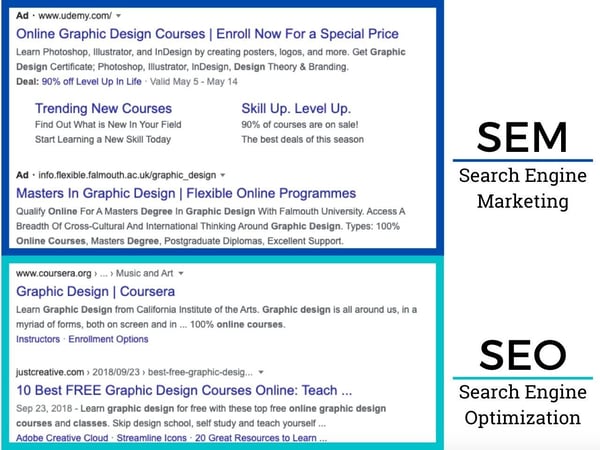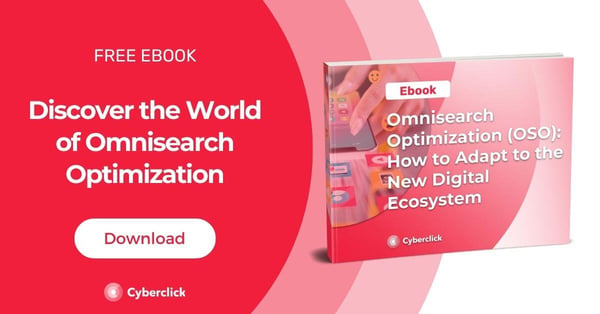What Is SEO? Definition, Advantages, and Examples
Index
- What Is SEO and How Can It Increase Your Website Traffic?
- Benefits of SEO
- A Guide to the Types of SEO
- How SEO is Evolving
- SEO vs. Content Marketing vs. Inbound Marketing
- Understanding Search Engines
- The 3 Pillars of SEO Strategy
- How to Create Good Content
- Balance Between Content and SEO
- The Technical Side of Content
- In Conclusion
SEO is an essential marketing technique that is focused on bringing organic, non-paid traffic to your website by using high-quality content to get you to the top of search engine results pages.
Reaping the benefits of your SEO labor may be a bit of a slow process at first, but once you’ve managed to achieve some results, your success will build upon itself.
In this article, we’ll give an in-depth explanation of everything you need to know about SEO, from what it is to how it works and the major pillars of SEO. Let’s get started!
What Is SEO and How Can It Increase Your Website Traffic?
SEO stands for Search Engine Optimization and is a marketing technique focused on optimizing your website to get it to rank as one of the top results on search engine results pages. Through a number of tactics and tools, you can organize your website in a way that search engines understand and choose to show to their users.
Think of SEO as both an art and a science. It combines the creativity and ability to create high-quality, engaging content that users value, with a strong understanding of analytics and of your prospective customers.
It's important to remember that SEO is only focused on organic ranking. You cannot pay to rank higher with SEO. The only way to rank higher with SEO is to ensure you're satisfying the search engine’s requirements.

Benefits of SEO
A strong SEO strategy can have a number of different benefits for your business’s online presence and your overall marketing strategy. These benefits can include the following:
- Increased visibility and traffic to your website: The higher your website pages rank on Google, the more traffic you’ll get.
- Improved website quality: There are several ways you must optimize your website to get it to meet Google’s high (and continually evolving) standards. By doing this, you’ll improve your website in the process.
- Build consumer trust: Search engine users naturally trust websites that rank at the top as there is a sense that Google has vetted the pages that appear.
- Establish your brand as an authority in your field: SEO involves a lot of content creation, like blog writing. Naturally, the more you write about a topic, the more people will turn to you as a valued source of information (but only if the content is high-quality, you can’t cheat with SEO.)
- Long-term plan: SEO may be a bit of a slower, long-term marketing strategy but, once gets going, it only grows. SEO is a long-term strategy that builds upon itself overtime and becomes more effective.
A Guide to the Types of SEO
There are actually many different kinds of SEO. In terms of SEO activities, the two main types are on-page SEO and off-page SEO.
On-page SEO refers to actions you conduct on your website to improve its ranking. This includes content creation, the use of keywords, the proper use of headings, meta descriptions, and URLs.
Off-page SEO refers to the actions you take outside of your website to improve its ranking in SERPs. This includes things like building backlinks, guest blogging, and social media marketing.
White Hat and Black Hat SEO are two different approaches to search engine optimization (SEO). White hat SEO is based on using ethical, transparent techniques to build your pages' rankings. This means following Google and other search engines' rules regarding website and position optimization.
On the other hand, black hat SEO uses questionable techniques to trick search engines into quickly raising a site's ranking. These techniques may include keyword stuffing, cloaking, and link farming. While black hat SEO may work in the short term, it is not sustainable and can actually damage your website over time. Search engines are constantly updating their algorithms to detect and penalize black hat SEO practices.
How SEO is Evolving
For years, SEO has focused on optimizing content for search engines like Google. AI-driven changes are reshaping how users search for information. Generative AI chats like ChatGPT and Perplexity and social media platforms like TikTok and Instagram have diversified search behavior. Businesses must optimize content for multiple digital touchpoints to ensure visibility where users actively seek information.
From SEO to Omnisearch Optimization
Omnisearch optimization (OSO) goes beyond traditional SEO. It considers all the digital platforms where users search for content, including Google, YouTube, TikTok, Instagram, and AI-powered chat tools. Instead of focusing solely on search engine rankings, omnisearch ensures that brands maintain a strong presence across various formats and platforms, adapting content to how users consume information today.
SEO vs. Content Marketing vs. Inbound Marketing
When you’re first getting started in the world of SEO, content marketing, and inbound marketing, it can be difficult to distinguish between these strategies. While they all involve some content creation and keyword research, they are distinct concepts that build upon each other.
Let’s start by discussing content marketing. Content marketing is a strategy that aims to create and distribute valuable content that attracts and retains users' attention. The goal of content marketing is to drive users to your website or social media channels, where you can convert them into leads or customers. Content marketing can take many forms, including blog posts, articles, videos, infographics, e-books, and more.
Now, let's delve into the role of SEO. SEO focuses on boosting the organic ranking of a website on Google using different techniques, one of which is content marketing. While attracting customers to your website is crucial in encouraging conversations, what happens after they arrive?
This is where inbound marketing comes into play. Inbound marketing is a non-invasive marketing approach that aims to attract, retain, and convert customers by utilizing a combination of diverse marketing techniques. These techniques can include content creation, SEO, marketing automation, and lead nurturing.
By understanding the different concepts of content marketing, SEO, and inbound marketing, you can create a more effective marketing strategy that will help you attract, convert, and retain customers.
Understanding Search Engines
As we talk about SEO and how it works, it's also important to understand how search engines work and how they determine what to rank. According to SemRush, “In English, worldwide, 88% of searches on desktop are on Google. On mobile, that figure is a whopping 96%. Bing and Yahoo combined account for 1.5% of searches on mobile and 8% of searches on desktop.” This means that ranking on the other search engines can be important, but Google is definitely still the main focus.
So, how does Google decide what to rank? When Google detects new content, it does three important things: crawl, index, and rank. Let’s review what this means.
Crawling
Crawling is the process of Google’s web crawlers (also known as spiders) visiting websites and collecting information about them. This information includes the website's content, structure, and links to other websites.
Indexing
Indexing is the process of storing the information collected by the web crawlers in Google's index. The index is a massive database of websites and their associated information.
Ranking
Ranking is the process of determining the order in which websites appear in search results. Google uses a variety of factors to determine a website's ranking, including the quality and relevance of its content, the number and quality of backlinks it receives from other websites, and the user's location.
The 3 Pillars of SEO Strategy
There are many different ways you can orient your SEO strategy. At Cyberclick, we believe that the following 3 pillars are essential for a strong SEO strategy: keywords, content, and website optimization.
Keywords
Keywords are the words and phrases that people use to search for information online. By understanding which keywords are relevant to your business and your customers, you can create content that is more likely to be found by those who are searching for it.
There are different ways to find the right keywords for your SEO strategy. One is to create buyer personas, which are semi-fictitious representations of your ideal customers. Once you understand your buyer personas, you can brainstorm short and long-tail keywords that relate to their needs, interests, pain points, concerns, and questions.
Using tools like Semrush and Google's Keyword Planner, you can analyze different keywords and determine whether they are a good fit for your brand and buyer personas.
Here are a few different factors to consider when conducting keyword research:
- Keyword search volume: The average number of times a particular keyword is searched for each month. You want to find keywords that have a high enough search volume to be worth targeting, but a low enough difficulty that they are competitive and you have a chance of ranking for them.
- Keyword difficulty: This is the measure of how difficult it is to rank for a particular keyword on Google. Depending on your domain authority, you want to use keywords that are difficult enough to be challenging. Just make sure that they are not so difficult that they are virtually impossible to rank for.
- Relevance: How relevant is the keyword to your business and your target audience? You want to find keywords that are closely related to your products or services, and that your target audience is likely to be searching for.
It’s important to note that keywords are not just single words. In fact, using groups of related keywords will help give your content a better shot at positioning on Google as well as provide more opportunities to answer queries.
Avoid keyword stuffing, as search engines no longer consider keyword density as a ranking factor. Instead, focus on creating high-quality content that is relevant to your target keywords and audience.
Content
After you have identified the right keywords, you can start creating content that is optimized for those keywords. This content should be high-quality, informative, and relevant to your target audience. It should also be well-written and engaging, so that people will want to read it all the way through.
Content marketing is a great way to attract people to your website and boost your SEO rankings. Joe Pulizzi, an expert in content marketing explains that “Content marketing is a strategic marketing approach focused on creating and distributing valuable, relevant, and consistent content to attract and retain a clearly-defined audience — and, ultimately, to drive profitable customer action.” This will also help improve your website's authority in the eyes of Google, which will lead to higher ranking in the search results.
Website Optimization
You’ve done your research and created your content. Now what? The final pillar of an SEO strategy is Website Optimization.
Website optimization is a broad term that refers to technical SEO and on-page SEO practices that serve to get web pages in the best shape for Google. This includes properly structuring content, using headers, titles, and alt text, optimizing for mobile, and taking care of loading times.
A lot of website optimization has to do with on-page SEO. While a big function of on-page SEO is content, there are also technical aspects like:
- Keyword strategy
- URL optimization
- Titles and meta descriptions
- Structure of page headings
- Image optimization
- Mobile friendly optimization
- Site map
- Load times
- High-quality content
- Content optimization
Let’s dive into some of these concepts.
How to Create Good Content
Your content will do nothing for your SEO if it is not engaging, valuable, and attention-grabbing. There are endless amounts of content formats to choose from, but, in general, opt for a format that your target audience consumes regularly and that is sustainable for you to produce.
.webp?width=600&height=450&name=Touchpoints%20-%20Funnel%20Advertising%20-%20David%20Tom%C3%A1s%20(1).webp)
The type of content that you create will depend on the stage of the buyer's journey that your target audience is in. The best content is that which applies to a user regardless of the phase of the funnel they’re in. This can include blogs, downloadable PDFs, ebooks, infographics, videos, newsletters, webinars, podcasts, etc.
Here are some of the characteristics of good content:
- It is easy to read: Use short sentences and paragraphs, clearly organized ideas, and headings for different sections.
- It is original: Never copy content! Google penalizes duplicate content, and they know who the original creator is.
- It is relevant to the buyer persona: Your content must always be centered on your buyer persona’s needs, questions, concerns, pain points, etc.
- It is SEO optimized: Include the keyword theme multiple times. But, don't overdo it or become obsessed with how many times it's used. Mention it naturally. Keyword stuffing will get you nowhere.
- It includes non-text elements: Include images, infographics, and videos when they can further the value of the content.
- It is valuable: The content provides your target audience with something that they value, such as information, education, or entertainment.
Balance Between Content and SEO
It is important to find a balance between creating content that is valuable to the user and optimizing that content for search engines. Ensure that you provide value to the user and aren't just advertising your brand, products, or services. Your content should also use the relevant keywords and themes so that your audience can find it.
Content alone does not attract people to your website if it is not well-researched and optimized. Think about how you can create something interesting that has the potential to be shared, while also being easy for Google to understand.
Also, don’t forget to have a bit of fun with your content. It does not always have to be practical. It can be entertaining or emotional as long as it fits with the research you’ve done.
The Technical Side of Content
Beyond just producing content, maintaining and optimizing your existing content is key. Here are some things to consider when managing your content:
- Internal linking: Link to other articles on your blog and to your pillar pages if you talk about a concept and have a related article. Remember, this is how Google’s spider finds and crawls your webpage.
- Pillar pages and topic clusters: A pillar page is what a topic cluster is built on. The pillar pages broadly cover a topic while the content cluster addresses a specific keyword related to that topic in greater depth.
- Off-page SEO: As mentioned above, off-page SEO consists of elements outside your website that contribute to your positioning. Off-page SEO includes a lot of content creation such as:
-
- Link building
- Industry forums and blogs
- Social media
- Video marketing
- Guest blogging
- Backlinks: Backlinks, also referred to as inbound links or link building, are links from external websites that link back to yours. They let Google know that you are trustworthy and authoritative.
- Guest blogging: Writing articles for other relevant, authoritative websites not only helps build an author’s or brand's reputation but also allows you to get inbound links from other trusted, authoritative sources. This is one of the best opportunities for an SEO specialist to build a backlink.
Optimized URLs
URLs should be easy to read and indexed by search engines. There are four simple rules for creating good URLs.
- Keep them short and simple
- Use only lowercase letters, numbers, and hyphens.
- URL must contain the keyword from the page’s content.
- Do not include years
Titles and Meta Descriptions
The title tag and meta description are two of the most important on-page SEO elements. The title tag is the text that appears at the top of the browser tab, and the meta description is the text that appears in the search engine results pages (SERPs).
Headings
Headings are important for organizing your written content and making it easy for readers to navigate. They should be used to divide your content into logical sections, and the headings themselves should be clear and concise. Be sure to organize your written content using the proper headings.
H1 headings should only be used for the main title. H2 headings should include your keyword and be used to organize major themes, while H3s and H4s are for introducing smaller concepts.
For example, below you can see all of the different headings in an article.

It is important to use a variety of keyword themes in each header, when relevant to the section. This is especially important when it comes to rich snippets and it's a great way to instantly boost your content to the top.
Optimizing Images
Search engine spiders can't "read" images the way a human would. Therefore, you need to help the spider interpret them. In the alt text, describe the image using the keyword of the content. You can simply use the same keyword from the title and meta description.
Also, try to keep images on the smaller side as far as file size goes. Try to only include jpg, png or gif formats. Jpg tends to be the smallest, which will help with loading times.
Responsive Design
Because most web traffic comes from mobile searches, you must ensure your website is optimized for mobile use. In fact, Google does not rank websites that are not mobile-friendly and indexed as mobile-first.
Ensure your website offers a good user experience for all screen sizes and fast loading times.
Loading Times
A page that takes too long to load results in high bounce rates and alienates visitors. It can also make the SEO positioning of a page worse, as Google will take this into consideration. Audit your site and optimize pages that are slow to load.
Sitemap
This is important for indexing. It can be done manually through Google, but most blogging platforms (like Wordpress or HubSpot) automatically create this. Remember to tell Google Search Console what your sitemap URL is, keep it up to date.
In Conclusion
There are certainly many more tactics and techniques that are important in the world of SEO. This quick beginner's guide serves as an introduction to SEO to help get you off to the right start!
Content & Marketing Strategist at Cyberclick, with an allbound approach and a specialisation in SEO, GEO and AI-driven automation focused on lead generation and conversion. With experience in HubSpot CRM, inbound marketing, corporate communications and public relations, she combines strategy, creativity and technology to drive business results.
Recursos para seguir aprendiendo: ebooks, vídeos y cursos

Cyberclick

Cyberclick

Cyberclick

Cyberclick

Cyberclick



